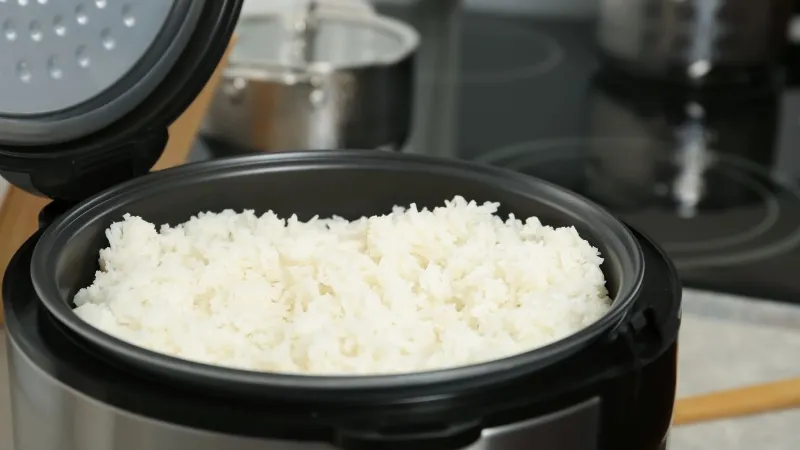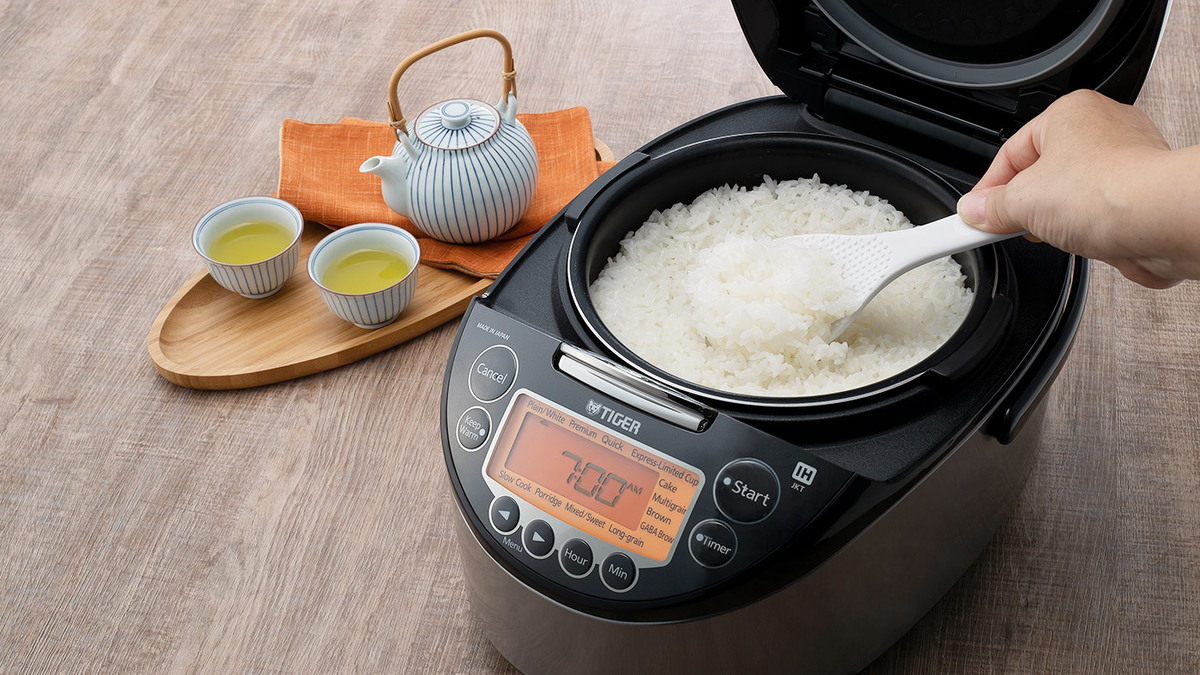Mastering the Art of Cooking Multigrain Rice in a Rice Cooker: A Comprehensive Guide
Written By James Morgan
When it comes to crafting a meal that's both delicious and nutritionally robust, understanding how to cook multigrain rice in a rice cooker can be a game-changer. Not only does multigrain rice offer a wonderful mix of flavors and textures, but it also provides an array of health benefits, making it the go-to choice for health-conscious individuals. In this exhaustive guide, we'll delve deep into the world of multigrain rice, exploring its benefits, the meticulous steps to prepare it using a rice cooker, and tips to make your dish truly stand out.

Why Choose Multigrain Rice?
The allure of multigrain rice lies in its delightful combination of different grains. Unlike traditional white rice, which is predominantly one type of grain, multigrain rice brings together the goodness of various grains like brown rice, red rice, quinoa, barley, and even millet. This diversity not only amplifies the taste but also ups the nutritional value significantly.
Brown rice is rich in fiber and antioxidants, making it excellent for digestion and overall health. Quinoa, a complete protein, offers all nine essential amino acids, which are crucial for muscle repair and growth. Barley is another great addition to your diet, known for its high fiber content and ability to control blood sugar levels. When you put all these grains together, you get a wholesome meal that supports heart health, reduces inflammation, and keeps you feeling full for longer.

Gearing Up: The Essential Cookware
1. Rice Cooker
Your primary tool for this adventure is a good quality rice cooker. With various brands and models available, it's crucial to choose one that suits your needs. Rice cookers range from basic models with just an on-off switch to advanced ones with multiple settings and functions. For cooking multigrain rice, having a rice cooker with a 'brown rice' or 'multigrain' setting can be very beneficial as these settings adjust cooking times and temperatures for optimal results.
2. Knife Set
A dependable knife set is indispensable in any kitchen, especially when preparing the accompaniments for your multigrain rice. Whether you're chopping vegetables, slicing herbs, or dicing fruits, a sharp knife ensures precision and safety. Invest in a high-quality, stainless-steel set that's comfortable to handle and easy to maintain.
3. Cutting Board
A sturdy cutting board is another kitchen essential. Opt for a board that's large enough to handle all your chopping tasks and is made of durable material. Wooden cutting boards are popular as they are gentle on knives and have a natural resistance to bacteria. However, they do require regular maintenance with cutting board oil to keep them in top shape.

Step-by-Step Guide to Cooking Multigrain Rice in a Rice Cooker
1. Rinse the Grains
Rinsing the grains is a critical first step when preparing multigrain rice. This process removes excess starch, which can cause the rice to become gummy or sticky when cooked. To rinse, place the grains in a fine-mesh strainer and rinse under cold running water until the water runs clear. This usually takes a few minutes and may require you to agitate the grains gently with your hands to ensure thorough rinsing.
2. Measure Ingredients
Accurate measurement is crucial for achieving the perfect texture and flavor of multigrain rice. Typically, a standard measure is 1 cup of multigrain mix to 2 cups of water, but this can vary slightly depending on the specific grains you're using. Always consult the instructions on your rice cooker or the grain package for precise ratios.
3. Soak the Grains
Soaking the grains before cooking helps to soften them and reduces the cooking time. For multigrain rice, soak the grains in water for about 30 minutes to 1 hour. If you're including harder grains like barley or farro, you may want to extend the soaking time to about 2 hours. After soaking, drain the grains well before adding them to the rice cooker.
4. Add Ingredients to the Rice Cooker
Once the grains are properly rinsed and soaked, transfer them to the rice cooker. Add the appropriate amount of water or broth to the cooker. Using broth instead of water can add an extra layer of flavor to your multigrain rice. You can also add a pinch of salt or a dash of olive oil for added taste.
5. Select the Right Setting
Most modern rice cookers come with multiple settings, including options for cooking different types of rice. If your rice cooker has a 'brown rice' or 'multigrain' setting, select it. This setting will adjust the cooking time and temperature to suit the denser, more fibrous grains in your mix. If your cooker only has a basic setting, you may need to cook the rice for a bit longer than usual.
6. Let It Cook
Once you've set your rice cooker, let it do its job. Avoid opening the lid during the cooking process, as this can release steam and affect the cooking time. Most rice cookers will switch to a 'keep warm' mode once the rice is done. Let the rice sit in the cooker for an additional 10-15 minutes after it switches to 'keep warm'. This resting period allows the grains to absorb any remaining moisture and results in a fluffier texture.
7. Fluff and Serve
After the resting period, open the rice cooker and gently fluff the multigrain rice with a fork. This helps to separate the grains and ensures an even texture. Serve the multigrain rice hot as a side dish or as a base for a more complex meal like a stir-fry or grain bowl.
:max_bytes(150000):strip_icc()/__opt__aboutcom__coeus__resources__content_migration__simply_recipes__uploads__2020__03__Rice-Cookers-LEAD-14-c55e0a43686f4428be2beb8e07079414.jpg)
Enhancing Your Multigrain Rice
Adding Vegetables and Herbs
To elevate your multigrain rice, consider adding fresh vegetables and herbs. Diced bell peppers, chopped scallions, and minced garlic can add bursts of flavor and color. Fresh herbs like parsley, cilantro, or basil can also enhance the dish's aroma and taste. Saut the vegetables in a bit of olive oil before adding them to the cooked rice for an extra layer of flavor.
Incorporating Proteins
For a more substantial meal, incorporate proteins such as grilled chicken, tofu, or shrimp. These proteins can be seasoned and cooked separately, then mixed into the rice. This not only boosts the nutritional value but also adds different textures and flavors to your meal.
Nuts and Seeds
Adding nuts and seeds to your multigrain rice can provide a satisfying crunch and additional nutrients. Toasted almonds, sunflower seeds, or sesame seeds are excellent choices. Sprinkle them over the rice just before serving to maintain their crunchiness.
Sauces and Dressings
A well-chosen sauce or dressing can transform your multigrain rice from ordinary to extraordinary. Drizzle a bit of soy sauce, teriyaki sauce, or a homemade vinaigrette over the rice. You can also add a dollop of pesto or a squeeze of lemon juice for a fresh, zesty kick. For some interesting sauce ideas, check out this Rice Cooker Meal guide.
Cleaning and Maintenance Tips
Proper cleaning and maintenance of your cookware ensure that they remain in excellent condition and continue to perform well. Here are some tips for caring for your essential kitchen tools:
Rice Cooker
After each use, clean the inner pot of your rice cooker with a gentle cookware cleaner. Avoid using abrasive sponges or cleaners that can scratch the surface. If there are any stubborn residues, soak the pot in warm soapy water for a few minutes before scrubbing gently.
Knife Set
Keep your knives sharp and in good condition by cleaning them immediately after use. Hand wash them with a mild detergent and dry them thoroughly before storing them. Regularly hone the blades to maintain their sharpness, and have them professionally sharpened when needed.
Cutting Board
Maintain your cutting board by cleaning it with hot soapy water after each use. For wooden cutting boards, apply a layer of cutting board oil regularly to prevent the wood from drying out and cracking. This will also help maintain its natural antibacterial properties.
As an Amazon Associate, I earn from qualifying purchases.
Final Thoughts
Mastering how to cook multigrain rice in a rice cooker can open up a world of culinary possibilities. With its rich texture and robust flavor, multigrain rice not only stands alone as a nourishing side but also complements a multitude of dishes. By following the steps outlined in this guide and incorporating your personal touches, you can create a versatile staple that's both delicious and beneficial for your health. You might also enjoy reading about cooking chicken breast for more inspirations on grilling.



